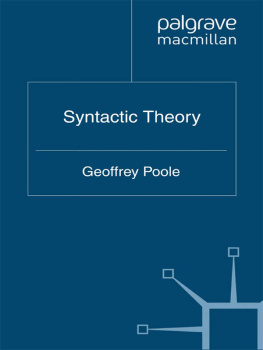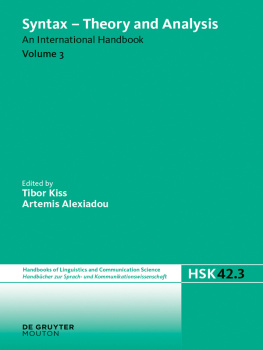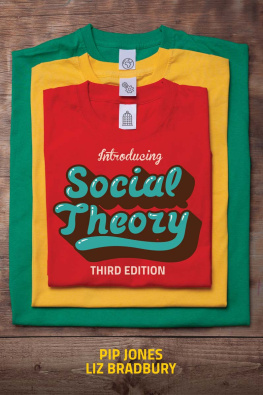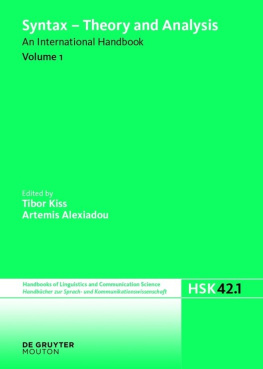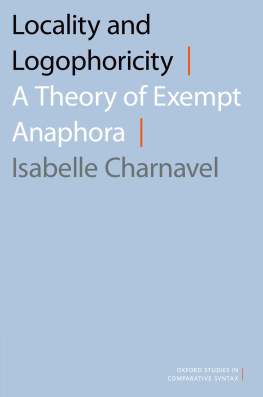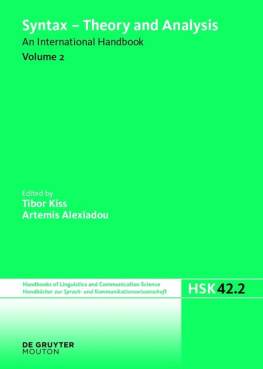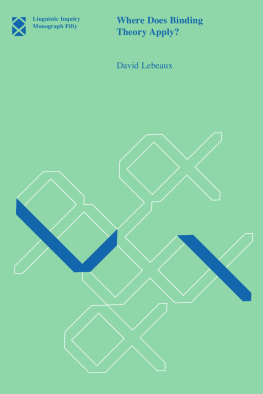SYNTACTIC THEORY
MODERN LINGUISTICS SERIES
Series Editor
Professor Maggie Tallerman
University of Newcastle
Each textbook in the Modern Linguistics series is designed to provide an introduction to a topic in contemporary linguistics and allied disciplines, presented in a manner that is accessible and attractive to readers with no previous experience of the topic. The texts are designed to engage the active participation of the reader, and include exercises and suggestions for further reading. As well as an understanding of the basic concepts and issues for each topic, readers will gain an up-to-date knowledge of current debates and questions in the field.
Titles published in the series
English Syntax and Argumentation (3rd Edition) Bas Aarts
Phonology Philip Carr
Pragmatics Siobhan Chapman
Linguistics and Second Language Acquisition Vivian Cook
Sociolinguistics: A Reader and Coursebook
Nikolas Coupland and Adam Jaworski
Morphology (2nd Edition) Francis Katamba and John Stonham
Semantics (2nd Edition) Kate Kearns
Syntactic Theory (2nd Edition) Geoffrey Poole
Contact Languages: Pidgins and Creoles Mark Sebba
Further titles in preparation
Modern Linguistics Series
Series Standing Order
ISBN 0333717015 hardback
ISBN 0333693442 paperback
(outside North America only)
You can receive future titles in this series as they are published by placing a standing order. Please contact your bookseller or, in the case of difficulty, write to us at the address below with your name and address, the title of the series and one of the ISBNs quoted above.
Customer Services Department, Palgrave Ltd
Houndmills, Basingstoke, Hampshire RG21 6XS, England, UK
Syntactic Theory
Second Edition
Geoffrey Poole


Geoffrey Poole 2002, 2011
All rights reserved. No reproduction, copy or transmission of this publication may be made without written permission.
No portion of this publication may be reproduced, copied or transmitted save with written permission or in accordance with the provisions of the Copyright, Designs and Patents Act 1988, or under the terms of any licence permitting limited copying issued by the Copyright Licensing Agency, Saffron House, 6-10 Kirby Street, London EC1N 8TS.
Any person who does any unauthorized act in relation to this publication may be liable to criminal prosecution and civil claims for damages.
The author has asserted his right to be identified as the author of this work in accordance with the Copyright, Designs and Patents Act 1988.
First edition 2002
Second edition 2011
Published by
PALGRAVE MACMILLAN
Palgrave Macmillan in the UK is an imprint of Macmillan Publishers Limited, registered in England, company number 785998, of Houndmills, Basingstoke, Hampshire RG21 6XS.
Palgrave Macmillan in the US is a division of St Martins Press LLC, 175 Fifth Avenue, New York, NY 10010.
Palgrave Macmillan is the global academic imprint of the above companies and has companies and representatives throughout the world.
Palgrave and Macmillan are registered trademarks in the United States, the United Kingdom, Europe and other countries.
ISBN: 9780230243934hardback
ISBN: 9780230243941paperback
This book is printed on paper suitable for recycling and made from fully managed and sustained forest sources. Logging, pulping and manufacturing processes are expected to conform to the environmental regulations of the country of origin.
A catalogue record for this book is available from the British Library.
A catalog record for this book is available from the Library of Congress.
10 9 8 7 6 5 4 3 2 1
20 19 18 17 16 15 14 13 12 11
Printed and bound in Great Britain by
MPG Group, Bodmin and Kings Lynn
Still for my parents, and for Maria,
and now for Alma and Tiago too
Contents
List of Figures and Tables
Figures
Tables
Preface to the Second Edition
Looking back on the Preface to the First Edition, written now nearly ten years ago, I suppose I should be pleased to see that I basically still agree with everything that I said there. (The alternative is that its a consequence of total intellectual stagnation, so Im sure thats not it!) For students, I suggest just flipping directly to the Preface to the First Edition to get a sense of what the book is about and the way that it approaches the subject of syntactic theory. This preface, being the Preface to the Second Edition, is more concerned with the differences from and similarities to the First Edition and their rationale, and so is oriented more towards teachers and other specialists who will be familiar with the First Edition.
In general, I still believe very strongly that theory-building and problem-solving are the most useful general skills one can learn from the study of syntactic theory at the beginning to intermediate level. And I still believe, even now in 2011, that that is better accomplished with Government and Binding Theory (and its associated literature), as opposed to the Minimalist Program.
As such, the early chapters of the book havent undergone any really radical changes. Ive tried to add little bits and pieces throughout, new sections here and there, extra trees, etc., to improve the discussion: for example, more detailed discussion of: A9 and P9 proforms and some additional case studies in .
Where things have changed a bit more is in the last few chapters of the book, some of which have been almost completely rewritten. , up to and including the interlude concerning Platos Problem. This discussion is, in my opinion, extremely important, and is the point at which, in my experience, students really viscerally understand the force of Platos Problem. (There are four different kinds of syntactic elements for which there is literally no evidence in the acoustic signal, because theyre never pronounced, and each of those four elements has a different combination of Binding Theory properties.)
The rest of the new continuing on to study the Minimalist Program in a further, more advanced, syntax course, these issues inform (sometimes implicitly, sometimes explicitly) the development of ideas in the Minimalist Program. Certain particular paths are pursued, certain kinds of data are deemed to be particularly important, in part because of the way these topics played out in Government and Binding Theory. As such, I think the study of these topics is still very helpful for understanding aspects of the Minimalist Program.
introduces arguments for topics such as reconstruction/the copy theory of movement and the movement analysis of Control.
Ive tried to retain the spirit of the previous edition in these new revisions. The tone of the chapters is intended to be informal but clear, and hopefully, as with the rest of the new edition, students both who continue on and who dont continue on with syntax will find something of value in them.
GEOFFREY POOLE
Newcastle University
(neThe University of Newcastle-upon-Tyne)
Preface to the First Edition
This may sound like an odd thing to say about a book entitled Syntactic Theory, but the fact that this book is about syntactic theory is, in certain respects, incidental. Ive written a book about syntax, and not quantum hydrodynamics, simply because I happen to know a little more about the former than the latter. (At least thats what my degree parchment says.) What this book is really about is theory-building: how to examine data, formulate and test hypotheses, and evaluate the results. Well be building towards a generic version of Government and Binding Theory, which was first outlined in a 1981 book by Noam Chomsky called
Next page
